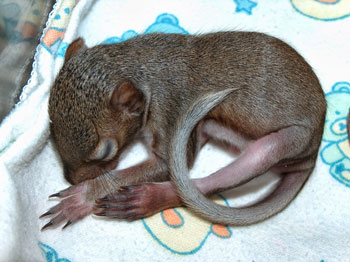TextBlock(text=”# How to Determine the Age of a Baby Squirrel
As an outdoor enthusiast and wildlife expert, I’ve encountered my fair share of baby squirrels during my time in the field. Whether you’re a nature lover or simply stumbled upon a tiny furry friend in need, knowing how to assess a baby squirrel’s age is crucial for providing proper care. Let’s dive into the fascinating world of squirrel development and learn how to be a squirrel’s best ally when they need it most.
The Importance of Identifying a Baby Squirrel’s Age
Before we get into the nitty-gritty details, it’s essential to understand why determining a baby squirrel’s age matters. Just like human babies, squirrel kits have different needs at various stages of development. Knowing their age helps us provide appropriate care, feeding, and decide whether they need professional wildlife rehabilitation.
Age Indicators: From Newborn to Fully Furred

Let’s break down the key stages of a baby squirrel’s development:
Newborn Squirrels: The Pink Jellybeans
Picture this: you’re out for a morning stroll and stumble upon what looks like a hairless pink jellybean. Congratulations, you’ve just met a newborn squirrel! These tiny creatures are:
- Mostly pink in color
- Lacking visible eye slits
- Sporting ears that are sealed flat to their head
At this stage, they’re incredibly vulnerable and in dire need of their mother’s care.
1-2 Weeks Old: The First Signs of Change
As the days go by, you’ll notice some significant changes:
- Dark coloration appearing on the head and back
- Eye slits becoming visible
- Ears starting to come away from the head
These little ones are still highly dependent but showing signs of growth.
3 Weeks Old: The Fuzzy Stage
By week three, our baby squirrel is starting to look more like its adult counterpart:
- Short fur covering most of the body, except for the belly
- Eyes still closed, but getting closer to opening
- More active and responsive to their environment
4 Weeks Old: On the Brink of Big Changes
The fourth week brings some exciting developments:
- Thicker fur all over
- Eyes almost ready to open – any day now!
- Lower teeth beginning to emerge
At this point, they’re becoming more curious about their surroundings.
5 Weeks Old: Hello, World!
Finally, at five weeks, we have a fully furred baby squirrel:
- Fur covering the entire body, including the belly
- Eyes wide open and taking in the world
- Upper teeth making their debut
Assessing Your Baby Squirrel’s Health

Now that you can pinpoint your squirrel’s age, it’s crucial to ensure they’re healthy. Here’s what to look out for:
- Body Condition: A healthy squirrel should feel plump, not bony.
- Fur: Look for a clean, fluffy coat without bald patches.
- Eyes: Once open, they should be clear and alert.
- Activity Level: Age-appropriate activity is key – older babies should be more active.
If something seems off, remember the ABC’s:
- Is the squirrel warm?
- Is it hydrated?
- Is it being fed properly?
When to Seek Help
While it’s tempting to care for a baby squirrel yourself, sometimes professional help is necessary. If you’re unsure about the squirrel’s condition or how to care for it, don’t hesitate to reach out to a wildlife rehabilitator. They have the expertise to give these little creatures the best chance at survival.
Conclusion: Be a Squirrel’s Best Friend

Understanding how to determine a baby squirrel’s age is the first step in providing appropriate care. Remember, while it’s exciting to encounter these adorable creatures, their best chance at survival is often with their mother or a professional rehabilitator.
Have you ever found a baby squirrel? Share your experience in the comments below! And if you found this guide helpful, don’t forget to check out our other articles on wildlife and outdoor adventures at Air Gun Maniac.”, type=’text’)






![Air gun 101: The differences between .177 & .22 – Which jobs they do best ? [Infographic]](https://airgunmaniac.com/wp-content/uploads/2020/09/g44-218x150.jpg)








































